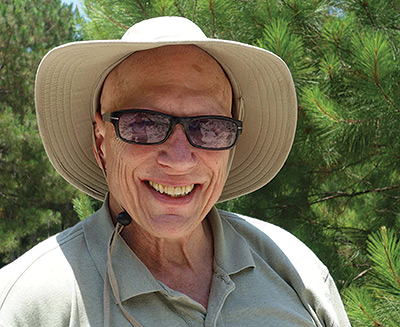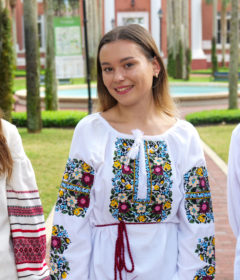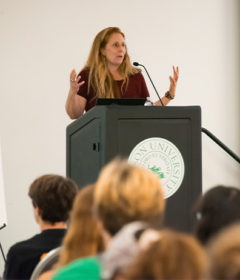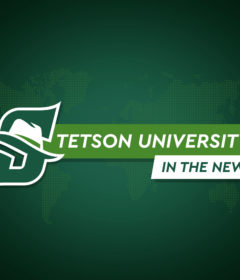When Something Comes Out of the Ground
by Ronald W. Williamson
Start at the beginning. Examine primary sources. Do the math. Walk the ground.
Basic tenets of investigation aren’t innovative in themselves, but the simple, elemental approach can be a powerful innovation when it swerves off the beaten path to challenge long-held, predominant beliefs.
A challenge to pillars of wisdom can be an audacious and potent innovation.
It can be a bit bruising, too, says Fletcher Crowe, Ph.D., B.A. ’65, a historian, former professor and career writer whose research touches a mystery at the deepest roots of United States history. His off-the-path work contradicts an important bit of established wisdom about short-lived “French Florida” and as such, he says, has been misrepresented, misunderstood and marginalized.

The scholarly snubs bother him a little, but his confidence is unshaken.
“They’re wrong, and we’re going to prove it,” said Crowe, project historian for The Fort Caroline Archaeology Project, a nonprofit that’s now involved in searching Southeast Georgia for indisputable evidence of the 450-year-old fort. He’s certain the project is looking in the right place and that history will be rewritten as a result of this work.
“Opposing opinions are expected since we take such a controversial and unorthodox position,” explains Crowe, “but our work is sound and scientific, well researched and carefully backed by years of study of historical documents.”
Short-lived Ambition
The project’s array of evidence argues that the traditional view is wrong about the place where hundreds of French settlers, many fleeing religious persecution, landed in 1564 to build houses and a fort they named for their king’s Carolingian dynasty. Fifteen months later, the Spanish king ordered the fledgling colony sacked. Hundreds of settlers were killed, the colony annihilated and French ambitions on the North American coast were squelched forever.
It had been Europe’s first attempt to build a permanent colony in what is now the U.S. The course of North American history changed there, but the site of that defining European clash is lost.
Numerous theories exist, but the prevailing view of historians, archeologists, anthropologists and others is that the bloody clash of cultures occurred on the south bank of the St. Johns River, just east of Jacksonville. The place is St. Johns Bluff, location of the National Park Service’s 1953 Fort Caroline National Memorial, a site backed with voluminous documentary evidence and maps – but not archeological evidence.
An outdoor interpretive exhibit of the fort stands near the museum at the memorial, but no one has discovered hard proof of a fort or colony there, despite many excavations and searches to prove the 150-year-old belief. The failures are understandable, says Crowe.
“It’s because Fort Caroline was not near Jacksonville!” he declares. “It was on a river in southeast Georgia. ”
That’s where archeology project field studies are underway and led by principal investigator, Anita Spring, Ph.D., a University of Florida anthropology professor emeritus who admits they have “a highly unorthodox thesis.”
The project’s focus in southeast Georgia has drawn skeptics, but they don’t dampen the convictions of Spring and Crowe.
“We are convinced that the evidence we have is clear,” asserts Crowe. “We hope to prove them wrong.” The project has conducted several expeditions in the Altamaha delta but has found no Fort Caroline artifacts.
“The team is making big plans for future investigations,” Crowe says. “We will make another grant application for further work and will keep our fingers crossed, while expanding our archeology efforts to other rivers.”
Crowe learned of Fort Caroline long ago from his European history studies at Stetson and Florida State University graduate school, but his interest intensified two years ago when he read a book written by 16th century French explorer Jean Ribault. Soon Crowe immersed himself in the subject. It surprised him that most research came from Spanish perspectives, not French.
“I found this to be too biased,” he points out, realizing he had the skills to research the original texts himself. “I am fluent in French and had taken all those courses at Stetson under Dr. Malcolm Wynn that dealt, in one way or another, with Renaissance France, and I could read 16th century French.”
One Degree North: A French Perspective
A tipping point came when he read of French mutineers who told Spanish soldiers that the fort was at 31 degrees latitude, Crowe recalls, about the same as Brunswick, Ga., and one degree north of the St. Johns.
“That was a huge discovery,” he remembers. “I was captivated, hook, line and sinker, and that moment cascaded into two years of scholarship on the fort. I came to the conclusion that the story of French Caroline had not been told very well from the French point of view. Everything about the French in Florida seemed to have a Spanish bias.”
He began work on a French perspective.
Crowe did not accept the conventional wisdom at face value. He started at the beginning, sought out primary sources and applied basic research principles first learned at Stetson University. He flew to Paris to study relevant 16th century materials at the Bibliothèque Nationale, seeking eyewitness narratives and navigation details.
The search for maps, documents and original source manuscripts took him to other institutions with significant primary materials in French, Spanish, English and Latin. He questioned earlier translations. He and his research partner, Spring, reconstructed words from extinct languages spoken by Native Americans near Fort Caroline. They poured over the earliest maps and applied precise calculations from later GPS readings and detailed coastal charts of today.
They walked miles on the sandy shorelines of the Altamaha delta.
“The Fort Caroline Archeology Project has developed a checklist of 42 characteristics of the fort’s location,” says Crowe, “and any proposed site for the fort can be tested and scored using those criteria. Many of the purported claims for the location of the fort do not even come close to meeting those site requirements.”
Questioning the Status Quo
Since the research went public in February 2014, Spring and Crowe have continuously shared their findings and rationale at town meetings, historical societies and scholarly conferences in Georgia and Florida. Their work meets with mixed reviews as one might expect of a theory that questions the status quo.
Crowe plans to use project research to publish a book about Fort Caroline “from its enthusiastic inception to its woeful conclusion,” and based on the belief that the fort was along the Altamaha — not along the St. Johns.
The book, he said, will be dedicated to the Stetson professor who introduced him to Renaissance France and helped him in a personal sense as well – “He was a major influence in my life,” Crowe now says.
“I remember Stan,” Wynn, 88, said. “He was an excellent student.” Crowe was known by his middle name while at Stetson. “He took four of my classes and got A’s in all of them,” recalls Wynn. “He had a very high GPA.”
Wynn retired in 2000 after 48 years on Stetson’s faculty. A scholarship for history and political science students is named for him, and now he’ll have a book dedicated to him.
“Dr. Wynn introduced me to myself,” Crowe said. “He believed in me and my potential. He encouraged me; he honored my talents and promoted the development of my skills. He made me feel that I could become a successful and capable adult.”
“It’s very kind of him to dedicate a book to me,” says Wynn. “Stan says I helped interest him in this subject, and I’m glad I did.”
Wynn expected his students to exhibit exceptionally good writing skills, Crowe remembers. He was strict about grammar, vocabulary, organization and construction.
“Being held to standards like that can be tough, but those standards stay with you for the rest of your life,” notes Crowe.
Another influencing professor was Hugh McEniry, Ph.D., an English professor who became university dean over the span of 1940-67. Crowe was one of the select students regularly invited to McInery’s home to contemplate and discuss democracy, law, enlightenment and other important concepts.
“It was magnificent,” Crowe says, recalling the circle of scholars.
While at Stetson, Crowe participated in the Junior Year Abroad Program and enrolled at the Center for Advanced European Studies in Strasburg, France. He knew he wanted to be a historian. His passion for history grew when his family vacationed at historic sites and when he worked as a United Nations staffer one summer in the Gaza Strip traveling in neighboring countries.
“The strongest and most lasting influence Stetson had on me,” says Crowe, is a “solid grounding in the humanities.”
Now that he’s retired and more reflective of life’s values and meaning, Crowe realizes the great value of the “true liberal arts” education he experienced at Stetson and is grateful for that unfailing foundation.
And the Fort Caroline Archeology Project infused new purpose in his life.
“I find deepest meaning and significance in trying to find this fort and have it preserved and protected for the legacy of generations to come,” he says.
This fort predates St. Augustine, the nation’s oldest city, he contends, as well as predating the Lost Colony of Roanoke by 21 years, Jamestown by more than four decades and the landing of the Pilgrims by 56 years. Children are taught about these places and their founders, but the story of Fort Caroline and its characters tends to be lost.
“We need to set the record straight,” he insists.
His project colleague says Crowe’s dedication is remarkable.
“A highly unorthodox thesis like our Fort Caroline work,” says Spring, a former dean, “demands great dedication, and Fletcher exemplifies that spirit admirably. He is an excellent researcher, questioning and examining every hint and clue.”
Out of the Ground
“Dr. Crowe is a tremendous scholar and historian whose research is very sound,” adds coastal ecologist Phillip Flournoy, now retired from a career with the University of Georgia and the state’s Department of Natural Resources.
Flournoy has confidence in Crowe’s work and believes he’s right about Fort Caroline on the Altamaha, “but the final determination will come when something of a concrete archaeological nature comes out of the ground.”
That “something out of the ground” perspective echoes the thoughts of many authorities that disagree with the Altamaha theory, but admire valuable research. Like the renowned colonial era historian Daniel Schafer, Ph.D., professor emeritus at the University of North Florida: he applauds the work, but wants to see archeological evidence.
A Fort Caroline on the Altamaha would be fine with him, said Shafer, who sees the current debate as a possible basis for creative disruption of old tenets.
“What really matters is locating the fort,” says Shafer. He has an innovative notion about that: establishment of a dream team of top multi-disciplined scholars and specialists to work tirelessly until the mystery is set to rest and the story properly told.
Crowe and Spring aim to set the mystery to rest without a dream team and tell a more accurate version of the old story, an Altamaha River story.
But the old St. Johns River story told at the Fort Caroline National Memorial won’t be easily be changed, said Barbara Goodman, the National Park Service superintendent who oversees the memorial and the museum there.
“The work on the Altamaha won’t change the story told at the memorial unless the lost fort is found elsewhere,” said Goodman. “A theory is only a theory until it is proven. The mystery of Fort Caroline remains a mystery.” Goodman lauds the Crowe and Spring work. “Questioning leads to discoveries,” she said.
Skeptics like Goodman and others don’t shake the resolve of Crowe or Spring.
“Sometimes I can feel a little dispirited and frustrated that we have not found anything concrete in the seven or eight places we’ve tested,” said Crowe. “There is a lot of chicanery related to Fort Caroline, but the simple truth is this: our evidence is scientific and sound; the fort was constructed near the delta of the Altamaha.
“This means that despite all the slings and arrows of outrageous fortune, we are certain that we are right and we must carry on.”
Ronald W. Williamson is a freelance writer in Central Florida.



